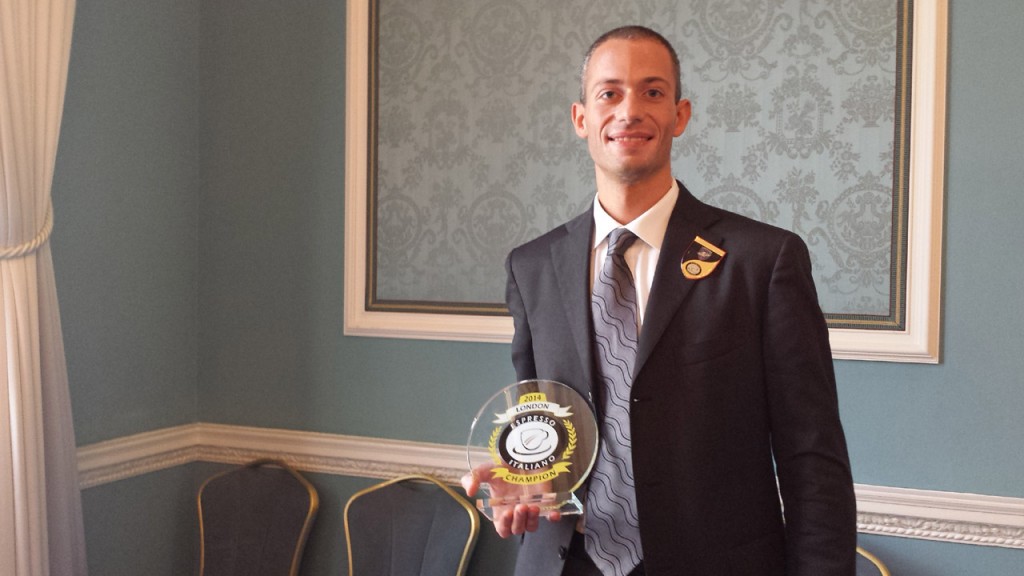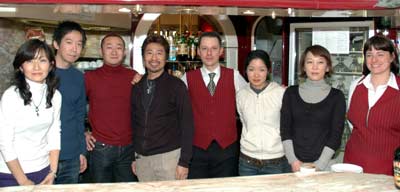by Roberto Sala
Barista. His bar, the Mary’s Bar in Costa Masnaga, in the North of Italy, was set up by his great-grandparents in 1928. He was brought up surrounded by machines, bags and cups. Fifteen years ago he started his job behind the counter: from 2001, he is a coffee taster and Espresso Italiano Specialist.In February 2007, he has been appointed to the board of the International Institute of Coffee Tasters. He is the first barista who has been appointed to such a role.
 Every day I pull up and down the shutter of my bar: we do this in my family ever since 1928. It’s now been 15 years since I started working behind the counter and preparing espressos and cappuccinos for those who, stopping by in this small town of mine in the North of Italy, decide to take a break or for the people who live here and regularly come to see me because they see my bar a part, so to say, an extra room, of their own house.
Every day I pull up and down the shutter of my bar: we do this in my family ever since 1928. It’s now been 15 years since I started working behind the counter and preparing espressos and cappuccinos for those who, stopping by in this small town of mine in the North of Italy, decide to take a break or for the people who live here and regularly come to see me because they see my bar a part, so to say, an extra room, of their own house.
I love this job. And I like to do it thoroughly. Every single detail is important. This is the reason why I want to begin this column by speaking about the importance of details, which, at the end of the day, are not really details in that they make the difference between a skilled barista and a less skilled one.
Let us consider, for example, the resins of the softner. If they are not regenerated, as time goes by, the limestone will damage the mechanical components of the machine. In my bar I have a manual softner. I had an electronic one but I replaced it because I was not satisfied with its results. With the manual one I am using, I must devote at least one hour per week to its maintenance, a reason for which being that if the machine does not work properly, the coffee is less creamy. What sort of espresso is an espresso with a cream that does not deserve that name?
As I already said, details are important. The bell of the coffee grinder is often abandoned to the fat component of the coffee which coats it little by little with an opaque layer. Cleaning it is not simple because it is necessary to be careful and completely remove the oxidised fat otherwise the cup of coffee will be rancid. Normally, I use warm water and smell-less detergent – this is extremely important because I do not want to have in the air aromas other than those of the coffee.
Here is another detail: the steam wand. This is an important message to the client. First of all, at the level of the image you give, it is really annoying to see all those, too many actually, encrusted steam wands. It is also, and especially, important from the sensory point of view: if a wand encrusted with milk from a previous cappuccino is used for a new one how can the milk be whipped without leaving in it unpleasant aromas?
Mere details? Well, preparing an espresso is about details. Here are some other details. When I open a bag of coffee the first thing I do is observe the shape of the beans and sense their aromas. It is best to let it “breathe” for a while and not use it immediately. After one hour, approximately, I can put it in the machine. It goes without saying that I taste it personally to check the quality. The visual characteristics can be monitored for each espresso, while the gustatory sensations, the olfactory ones which are perceived directly and those which are perceived at the back of the mouth must be monitored all throughout the day. Indeed, many conditions can vary and have a negative impact on the sensory effect of the espresso. The basic parameters must, of course, always be kept under control: the pressure of the machine at 9 atmospheres, the water must be injected in the group at 88°C and the 7-gram dose of coffee must give in 25 seconds precisely 25 millimetres of espresso.
Some people might think that it is nothing more than an espresso. Some others might as well believe that the attention devoted to the very details in the preparation of the cappuccino is a gross exaggeration. Nonetheless, it is all about this: it is all the details that make the cup unique for our client. Otherwise, it is just a bit of ground coffee that undergoes a certain pressure. And so much for the pleasure of coffee.

 I’m increasingly committed to training. Alongside my job at the coffee shop, I’m frequently asked to teach. Recently I had the opportunity to teach to a group of will-be barista who all started basically from scratch. People of all ages and without any experience. What to do when you find in front of yourself a bunch of pupils who have no idea whatsoever on the work they’re going to do? You start from the basics. This is the reason why I tried to teach them all the basics bearing in mind the fears and difficulties that learning a new job comes with. I taught them the basics of coffee-making, I introduced them to the machines, I told them when and how to use and clean them, and about the preparation of the product. We went, as much as the available time made it possible, into the very details and I tried, above all, to pass on to them my personal experience. I also taught them about aperitifs and cocktails but I preferred focusing on the preparation of coffee, stressing the rules of the International Institute of Coffee Tasters and the Italian Espresso National Institute. I had one thought in my mind: it was fundamental to me that the pupils understood the importance of espresso and especially that they understood that the coffee at the bar must trigger emotions in the client. The pupils had to face up to several difficulties many of them coming mainly from the fact that they had no knowledge of the machines. I also noticed a certain mistrust in their abilities and a bit of fear in facing a product they did not know. Time was against them: they had to learn everything in a few hours only. They were, however, supported by a strong desire to learn which reassured me. Beyond technical doubts, the pupils were all nervous for the start of their new business, some of them were afraid about not being able to face the client. How can you become self-confident in doing your job, how can you make sure that the client will come back? An ages-old question with a similarly ages-old answer: offer high quality products with kind manners.
I’m increasingly committed to training. Alongside my job at the coffee shop, I’m frequently asked to teach. Recently I had the opportunity to teach to a group of will-be barista who all started basically from scratch. People of all ages and without any experience. What to do when you find in front of yourself a bunch of pupils who have no idea whatsoever on the work they’re going to do? You start from the basics. This is the reason why I tried to teach them all the basics bearing in mind the fears and difficulties that learning a new job comes with. I taught them the basics of coffee-making, I introduced them to the machines, I told them when and how to use and clean them, and about the preparation of the product. We went, as much as the available time made it possible, into the very details and I tried, above all, to pass on to them my personal experience. I also taught them about aperitifs and cocktails but I preferred focusing on the preparation of coffee, stressing the rules of the International Institute of Coffee Tasters and the Italian Espresso National Institute. I had one thought in my mind: it was fundamental to me that the pupils understood the importance of espresso and especially that they understood that the coffee at the bar must trigger emotions in the client. The pupils had to face up to several difficulties many of them coming mainly from the fact that they had no knowledge of the machines. I also noticed a certain mistrust in their abilities and a bit of fear in facing a product they did not know. Time was against them: they had to learn everything in a few hours only. They were, however, supported by a strong desire to learn which reassured me. Beyond technical doubts, the pupils were all nervous for the start of their new business, some of them were afraid about not being able to face the client. How can you become self-confident in doing your job, how can you make sure that the client will come back? An ages-old question with a similarly ages-old answer: offer high quality products with kind manners.

